Dr. Cathy Kapica, Global Nutrition Director of McDonald’s corporation, was not seen publicly burning copies of Eric Schlosser’s books during her visit to Taiwan last week. But chances are that this leg of her Asia tour was part of a major PR campaign to discredit the author’s new book and film about the fast food industry, which are said to have caused quite a stir in the corporation’s headquarters. However, there may be little cause for concern for McDonald’s in Taiwan, where the fast-food giant has successfully charmed its way into the hearts of consumers and government officials alike, blurring the line between health education and junk-food propaganda.
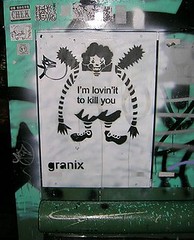
Grafitti in Xi-men Township, Taipei.
When addressing a health-conscious audience, Dr. Kapica, just like her good friend Ronald McDonald, knows better than to brag about the company’s burgers. Instead, she comes armed with a lot of good, wholesome advice. For instance, on Saturday 20 May she talked about “helping children choose nutrient-rich foods” at a conference at Taichong’s Hungkuang University, co-organized by the Chinese Nutrition Society.
The Society is just one of many groups with whom McDonald’s has succeeded in forming cozy partnerships in Taiwan. The Department of Health currently endorses the company’s most well-known PR agent, Ronald McDonald, as he tours schools to educate children on health and hygiene. Also, in 1999 McDonald’s was granted permission by the Koo Foundation Sun Yet-Sen Cancer Center to set up Taiwan’s first “Ronald McDonald Family Room” for the visitors of sick children, which has since been replicated in other hospitals around the country.
Yet it was less than ten years ago that courts in England ruled against the corporation on several charges relating to precisely this kind of false, manipulative PR campaigning. In the longest-running legal battle in English history, known as McLibel, activists Dave Morris and Helen Steel successfully proved that the company exploited children, was misleading in the healthy images portrayed in its advertising, and that eating too much McDonald’s food was linked to heart disease. Since the trial, the negative health, social and environmental effects of the fast food industry have been repeatedly highlighted in books, films and on websites.
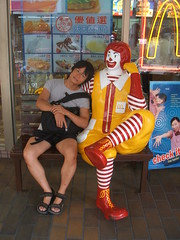
The friendly clown: Sansia, Taiwan.
So where was Taiwan when all this was going on? Everywhere one looks today, Ronald McDonald seems to have his big red foot in the door of some government agency, school or health institution, and is becoming an ever-more robust Trojan horse in the corporation’s campaign to keep kids munching on fries. Indeed, Ronald’s mission has not been affected by the attacks on his creators, but he has instead been given a makeover and sent back out into society reinforced with a smart new set of principles - stolen straight from the mouths of his fiercest critics. And all it took was a little cut and paste job from the Dummie’s Guide to Nutrition.
At a meeting on 22 May with Sheu Hui-yu, Director of the Nutrition Division at Taiwan’s John Tung Foundation, Dr. Kapica revealed one of the clown’s favorite weapons – a triangular tool originally developed by his adversaries and later assimilated for him by McDonald’s. Nutritionists Kapica and Sheu sat face-to-face across the Foundation’s conference table, each brandishing her own model of this tool, the “food pyramid”, a diagram indicating the recommended daily consumption of grains, fruits, vegetables, proteins, fats and sugars.
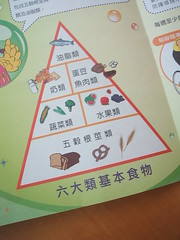
The food triangle according to McDonald's.
When asked whether any of the meal options at McDonald’s actually conform to the diet represented by the pyramid displayed in the company's promotional materials, Dr. Kapica indicated that there were certain “choices” on the menu that could be made, failing to elaborate on which items those might be, and how they might contribute to a balanced diet.
“Have you seen our menu lately?" Kapica responded as her colleague fished out the latest local menu with its usual selection of burgers, fries and…oh! A packet of corn.
Perhaps the questions were not specific enough, not giving the McDonald’s nutritionist due chance to fully display her wisdom and expertise.
Why was it, then, that for about the same weight of fries, the nutritional information provided for Taiwan was totally different from that in China or the US? Sheu pointed to the salt and calorie columns on the latest McDonald’s handouts.
Dr. Kapica was quick to respond. This was because the methods used for testing data varied from country to country, and they were presently working out how to standardize the system - a considerable challenge in a world with no example to follow. Thus her reply on behalf of the company most famous for its unprecedented global standardization of flavors, main streets, and every last detail of behind-the-counter operation.
Errors in the data could be excused, she added, for they at McDonald’s “provide more information than any other restaurant in the world.”
Politely ignoring the hyperbole, and still bothered by the inconsistency in nutritional data provided to Taiwanese customers compared to their foreign counterparts, Sheu pointed out that, in order for all that information to be meaningful, it would have to possess some element of precision, and that an error of factor 10 was stretching it a little.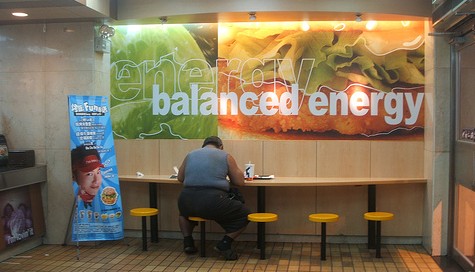
The McDonald's balanced diet, Roosevelt Road, Taipei.
They discussed the famous Taiwanese Rice Burger, which Dr. Kapica admitted was considered a healthy option, yet was unprepared to explain why the chicken rice burger has higher fat and calorie levels than a Big Mac.
This, again, could be considered misleading. However, Sheu explained, she did not expect something as unreasonable as for the company not to sell its food. What concerned her most was the welfare of Taiwanese children, whose eating habits were being influenced by McDonald's marketing. For example, just what kind of message did Dr. Kapica think Ronald McDonald was conveying to kids on his visits to schools?
Dr. Kapica’s Taiwanese colleague, Deputy Assitant Manager of Sales and PR Chen Wei-Ya, explained that the purpose of sending Ronald to schools was to teach children to wash their hands. Was that all? No, she said, he also instructed them on healthy eating.
“Kids are more likely to do what Ronald McDonald tells them to do,” she said, and gave a demo of Ronald in action. “McDonald’s is a life choice. When you eat at McDonald’s, you also have to eat fruit and vegetables, and do exercise…”
She seemed almost charmingly unaware of her blatant admission that Ronald was simply a company salesman with a painted face. Yet one look at the hand-washing guides provided to schools by McDonald’s Taiwan confirms this reality; “Wash your hands before you eat,” advises the caption beside an illustration of a McDonald’s burger, fries and drink.
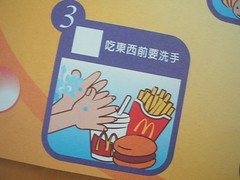
"Wash your hands before you eat..."
“We’re seriously looking at ways to get children to eat more fruits and vegetables,” Dr. Kapica assured, and proceeded to describe a few of the ways in which McDonald’s claims to be attempting to do so. Firstly, there are apple slices in American outlets, which come accompanied by a low-fat dip.
“But is it high in sugar?”
“Of course it’s sweet!” Dr. Kapica retorted. “But will children eat apples without it?”
She then expounded a theory that, after eating a lot of apple slices with the caramel dip, children would try them without the dip, and possibly find that they liked the apple by itself. This was followed by a description of efforts in Australia, where flavored straws are being used to make drinking milk more fun for children.
“But the ingredients of the straw are also good, right?” asked Chen.
“Well…it’s flavor,” came the reply. “Chocolate or banana…”
As she progressed with these examples, it became clear the bizarre kind of image she was trying to paint of McDonald’s: that of an unfortunate victim of the poor eating habits of modern society, which it was heroically trying its utmost to reverse.
“We tried forty vegetables with kids – they ate none of them!” she said. “We have to work with other people to say, “children need to eat this!”
Was McDonald’s, then, prepared to stop advertising its existing menu to children until a day came when it could offer the healthier food it was trying so hard to introduce? No, Dr. Kapica could see no sense in that, and anyway, she had no idea what was meant here by “healthy”.
And the feeling was mutual - was the guiding principle behind McDonald’s health drive, after all, to use additives and sugary dips to lure children into consuming milk and fruit, or to harness the innocence of milk and fruit to wean them onto additives and sugary dips? Would the corporation one day be claiming that babies have an innate repulsion towards breast milk that could only be overcome by smearing McDonald’s cherry-flavored gel on the nursing mother’s nipples, upon which the in-house nutritionists could then cry in anguish, “Of course it’s full of chemicals, but will babies feed without it?"
Whether or not the corporation would go the small extra distance to promote such an absurdity, the fact remains that, as company reps told Sheu ten years ago, if McDonald’s were to sell healthy food, it wouldn’t be McDonald’s. Even as Dr. Kapica talked about nutrition in Taipei, a UK newspaper reported that McDonald’s is abandoning its attempts to sell healthier foods in America and Britain, and instead bringing out bigger burgers than ever, which has caused renewed concern about the corporation’s contribution to diet-related health problems amongst children and the less wealthy.
Of course no one should have the right to dictate what others eat. But while it is up to the individual customer to make this choice, there is something very sinister about a company that intentionally works its way into the consciousness of small children, plumping them up for the obesity ward while sending a smiling clown to sing songs with the kids suffering from cancer next door. As Helen Steel said during her McLibel campaign, “Ronald McDonald is one stranger parents certainly should warn their children about - we know he has ulterior motives.” The Department of Health should take note.
1 comment:
MacDonalds is evil
Post a Comment